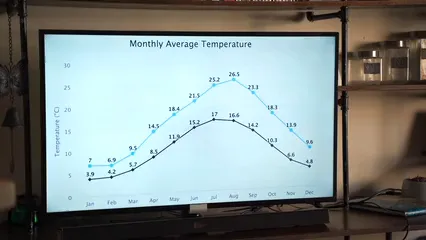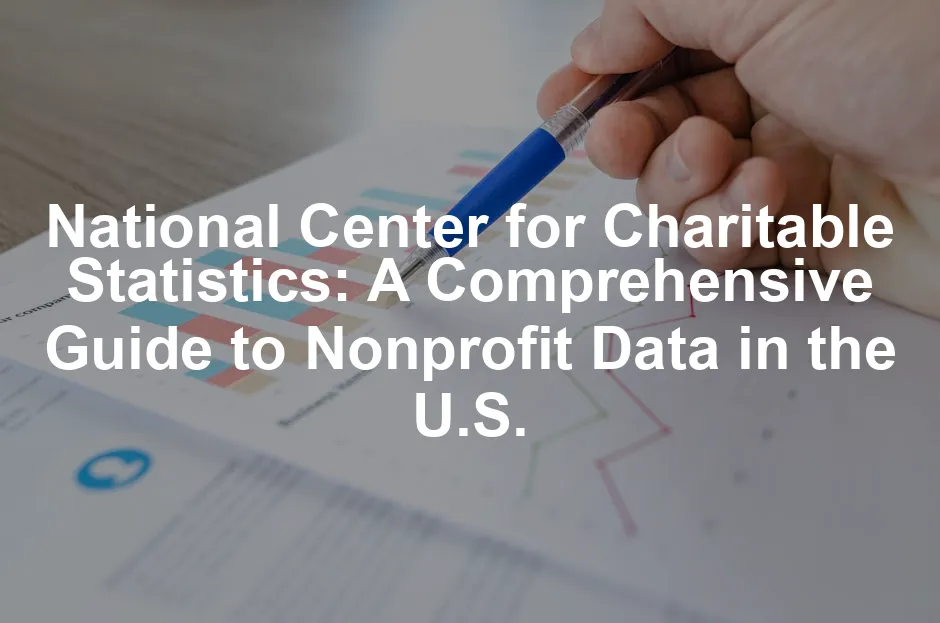Introduction
The National Center for Charitable Statistics (NCCS) is more than just a data repository; it’s a lifeline for understanding the nonprofit landscape in the United States. Established in 1982, this invaluable resource aims to enhance transparency and foster informed decision-making in the nonprofit sector. It serves as a vital platform for researchers, policymakers, and organizations to access crucial data about charitable entities, ensuring that the nonprofit sector operates in a transparent and effective manner.
Why should we care about nonprofit statistics? Well, think of it this way—imagine trying to navigate a maze without a map. That’s what stakeholders face without proper data. Researchers rely on NCCS data to understand trends and changes in the sector, while policymakers need accurate statistics to craft regulations that benefit both nonprofits and the communities they serve. Even organizations themselves can use this data to benchmark their performance and identify areas for improvement.
In the sections that follow, we’ll explore the foundation of NCCS, including its history and mission, as well as the datasets available through this essential resource. You’ll learn about the key milestones that have shaped NCCS, its vision for the future, and how you can leverage this data for your own research or organizational needs. So, grab your favorite beverage, and let’s navigate the world of nonprofit data together!

The Foundation of NCCS
History of NCCS
The National Center for Charitable Statistics was born on March 15, 1982, as a research division of Independent Sector. At that time, there was a significant gap in understanding the nonprofit landscape, making it difficult to gauge how donations were utilized. Russy Sumariwalla, the center’s inaugural executive director, played a pivotal role in laying the groundwork for what would become a crucial resource for the nonprofit sector.
Fast forward to 1996, and the NCCS found a new home at the Urban Institute’s Center on Nonprofits and Philanthropy. This transition marked a significant leap forward for NCCS, allowing it to expand its reach and influence. One of its key contributions during this period was the development of the National Taxonomy of Exempt Entities (NTEE) classification system. This system categorizes nonprofits into over 100 distinct categories based on their missions and activities, allowing for a more nuanced understanding of the sector.
Mission and Vision
NCCS is on a mission to serve as the national repository of nonprofit data. Its goal is to provide high-quality, accessible information that promotes research and understanding of the nonprofit sector. By collaborating with various stakeholders, including the IRS and academic institutions, NCCS aims to build a comprehensive database that supports the evolving needs of nonprofits and their funders.
The vision is clear: enhance the understanding of the nonprofit sector and improve its effectiveness. By providing data that is both reliable and relevant, NCCS empowers stakeholders to make informed decisions, ultimately leading to stronger, more effective nonprofit organizations. If you’re looking to deepen your understanding of nonprofit management, consider grabbing a copy of Nonprofit Management: Principles and Practice. This book is a fantastic guide for anyone looking to navigate the complexities of nonprofit leadership.

Datasets Offered by NCCS
Overview of Available Datasets
The National Center for Charitable Statistics (NCCS) is a treasure trove of data about the nonprofit sector in the United States. It houses a wide variety of datasets that serve as a crucial resource for researchers, policymakers, and nonprofit organizations. These datasets cover everything from financial filings to organizational information, helping users understand nonprofit trends, performance, and impact.
One of the significant aspects of NCCS datasets is their role in promoting transparency. They enable stakeholders to access reliable information about nonprofits, fostering accountability and informed decision-making. Researchers utilize these datasets to analyze trends, assess the financial health of organizations, and evaluate the overall landscape of the nonprofit sector. Policymakers, on the other hand, draw on this data to craft regulations that facilitate a healthy environment for charitable entities.
Let’s look at some key datasets offered by NCCS:

IRS 990 Tax Data
The IRS 990 Tax Data is perhaps the crown jewel of NCCS datasets. This dataset includes information from the Form 990, which nonprofit organizations are required to file annually with the Internal Revenue Service. It encompasses a broad range of financial details, such as revenue, expenses, and compensation for top officials. If you’re looking to understand the intricacies of nonprofit financial management, consider picking up Nonprofit Financial Management. This book offers essential insights into managing nonprofit finances effectively.
Why is this dataset so important? For starters, it provides insights into how nonprofits allocate their resources. Funders can analyze these filings to determine how organizations utilize contributions and make informed giving decisions. Moreover, researchers can use this data to study sector trends over time, enabling them to identify patterns and shifts in nonprofit operations.

Business Master File (BMF)
Next up is the Business Master File (BMF), which lists all active nonprofit organizations that have been granted tax-exempt status by the IRS. This dataset is vital for anyone looking to understand the sheer number and diversity of nonprofits across the country. It serves as a foundational resource for researchers and organizations seeking to identify active players in the nonprofit sector. If you’re interested in a comprehensive guide to nonprofit organizations, check out The Complete Guide to Nonprofit Organizations. It’s an essential read for anyone wanting to dive deeper into the nonprofit world.
The BMF is regularly updated, ensuring that users have access to the most current information available. From identifying potential partners to assessing competition, this dataset is a go-to for anyone involved in the nonprofit world.

Revocations Database
The Revocations Database is another critical component of NCCS’s offerings. It contains records of nonprofit entities that have had their tax-exempt status revoked. This dataset is significant for understanding compliance issues within the sector. If you want to understand nonprofit law better, consider reading Nonprofit Law: The Life Cycle of a Nonprofit. This book provides crucial insights into the legal frameworks governing nonprofits.
When a nonprofit loses its tax-exempt status, it can have serious consequences for the organization, including loss of funding and trust. By analyzing this data, researchers can explore the reasons behind revocations, identify trends, and ultimately help inform better practices within the sector.

Detailed Dataset Descriptions
IRS 990 Efilers
The IRS 990 Efilers dataset focuses on nonprofit organizations that file their Form 990 electronically. This dataset allows for a more streamlined analysis of filing data and enhances transparency. With electronic filings, researchers can quickly access, analyze, and compare information across various organizations. This efficiency helps ensure that nonprofits are held accountable for their financial practices. Interested in honing your skills in data analytics for nonprofits? Check out Data Analytics for Nonprofits for more insights.
NCCS Core Files
The NCCS Core Files are a comprehensive compilation of data derived from the IRS Business Master File and financial variables from the IRS Return Transaction Files. These core data files are structured to facilitate longitudinal studies, allowing researchers to track changes in the nonprofit sector over time. The information is meticulously curated, ensuring that it remains relevant and useful for analysis. If you’re looking for a foundational text on nonprofit leadership, consider Nonprofit Leadership: A Practical Guide. This book is a valuable resource for anyone stepping into a leadership role in the nonprofit sector.
These core files include separate datasets for public charities, private foundations, and other tax-exempt organizations. The availability of these different categories enables a more nuanced understanding of the diverse activities and impacts of various types of nonprofits.

Geographic Filters
Geographic filters are a fantastic feature of NCCS datasets. They allow users to integrate geographic data into their analyses, enhancing the contextual understanding of nonprofit operations. By adding geographic filters, researchers can examine regional trends, compare nonprofit performance across states, and identify local needs. This feature adds depth to the analysis and helps tailor strategies to specific communities.
In summary, the datasets offered by the National Center for Charitable Statistics are invaluable for anyone interested in the nonprofit sector. They provide essential insights into the workings of nonprofits, promoting transparency and informed decision-making. Whether you are a researcher, a policymaker, or a nonprofit leader, tapping into these datasets can significantly enhance your understanding of the nonprofit landscape in the United States. For effective data analysis techniques, you may want to check out the tips for effective data analysis in economics and statistics.

Understanding how to analyze data effectively is crucial for making informed decisions in the nonprofit sector. Learn more about effective data analysis techniques here.
Utilizing NCCS Data
How to Access NCCS Data
Accessing data from the National Center for Charitable Statistics (NCCS) is as easy as pie. Here’s a step-by-step guide to get you started.
1. Visit the NCCS Website: Head over to the official NCCS website at nccs.urban.org. This is where all the magic happens!
2. Navigate to Datasets: Click on the “Datasets” tab. You will find a treasure trove of information waiting for you.
3. Choose Your Dataset: Browse through the available datasets. You’ll see options like IRS 990 Tax Data, the Business Master File (BMF), and more. Each dataset comes with a brief description to help you decide what you need.
4. Download Your Dataset: Once you’ve made your selection, click on the “Download” button. Some datasets are available in various formats, so pick the one that suits your needs best.
5. Explore the Data: Open the downloaded file and start exploring! Whether you’re analyzing trends or creating reports, you now have access to valuable data.

If you’re feeling fancy, check out the Custom Report Builder. This tool allows you to create tailored reports based on your specific criteria. It’s like having a data genie at your fingertips!
Alternatively, the menu-driven report creation tool is perfect for those who prefer a more guided approach. Simply follow the prompts to generate your report without breaking a sweat.
These resources make accessing and utilizing NCCS data a breeze. Dive in and start uncovering insights that can shape the future of the nonprofit sector! For those looking to sharpen their fundraising skills, don’t miss The Complete Guide to Nonprofit Fundraising. It’s filled with strategies that can help elevate your fundraising efforts!

Key Research Areas
Now that you know how to access NCCS data, let’s chat about the key research areas you can explore. The datasets unveil a plethora of insights that are crucial for understanding the nonprofit landscape.
1. Trends in Nonprofit Funding: Analyze funding sources, amounts, and distribution trends over the years. This information is vital for donors and nonprofits alike, as it helps identify where the money is flowing and which areas require more support.
2. Operational Practices: Curious about how nonprofits run their operations? NCCS data can shed light on best practices, financial health, and efficiency metrics. It’s like peeking behind the curtain to see what makes nonprofits tick! For a deeper dive into operational practices, check out Nonprofit Organizational Culture. It explores the dynamics that drive successful nonprofits.

3. Sector Impacts: Understanding the broader impact of the nonprofit sector is essential for stakeholders. Research can focus on how nonprofits contribute to community development, social change, and economic growth. With the right data, you can paint a clear picture of the sector’s role in society.
4. Compliance and Regulation: The NCCS datasets also allow researchers to study compliance issues, such as tax-exempt status revocation trends. This insight is crucial for regulatory bodies and nonprofits to ensure adherence to laws and regulations.
5. Demographic Insights: Want to know more about the demographics of nonprofit organizations? The data can provide insights into the types of nonprofits, their missions, and geographic distributions.

By tapping into these key research areas, stakeholders can harness the power of NCCS data to make informed decisions, develop effective strategies, and ultimately strengthen the nonprofit sector. Interested in learning more about nonprofit storytelling? Don’t miss Nonprofit Storytelling for Change. It’s a great resource for honing your communication skills!

Insights from NCCS Research
Featured Studies and Reports
NCCS research produces valuable insights that help us understand the nonprofit sector better. One standout publication is the Nonprofit Sector in Brief. This report provides an overview of trends in the number and finances of 501(c)(3) public charities. It’s the go-to resource for anyone looking to grasp the current state of nonprofits.
The report highlights significant findings, such as shifts in funding sources and changes in operational practices. For instance, it often showcases how economic factors influence charitable contributions. This kind of data helps nonprofits strategize and adapt to changing environments. If you want to dive deeper into nonprofit trends, consider reading Nonprofit Trends and Impacts Report. It’s packed with insights!

Another notable study is the Nonprofit Trends and Impacts report. This research provides a nationally representative survey of nonprofit organizations, focusing on their operations and impacts. It gives us a glimpse into the everyday workings of nonprofits, including direct service provision, community building, and advocacy efforts.
Key Findings
What’s the big takeaway from NCCS research? Here are some key findings that stand out:
- Funding Fluctuations: The nonprofit sector often experiences funding fluctuations based on economic conditions. When the economy thrives, charitable giving tends to increase. Conversely, during downturns, donations may dwindle.
- Operational Efficiency: Many nonprofits are improving their operational efficiency. By leveraging technology and data analytics, organizations can streamline processes and maximize their impact.
- Sector Growth: The nonprofit sector continues to grow, with new organizations emerging regularly. This growth reflects the increasing demand for social services and community support.
- Diverse Missions: Nonprofits are not a one-size-fits-all sector. They span a wide range of missions, from environmental advocacy to education and health services. This diversity is crucial for addressing various societal needs.
- Community Impact: Research shows that nonprofits play a vital role in community development. They enhance civic engagement, strengthen social bonds, and drive positive change.
In summary, insights from NCCS research are invaluable for understanding the dynamics of the nonprofit sector. By utilizing these findings, stakeholders can make informed decisions that foster transparency and effectiveness in charitable organizations. For a comprehensive overview of nonprofit governance, consider reading Nonprofit Governance: Law and Practice. This book offers critical insights into the legal framework of nonprofit organizations.

Case Studies
Organizations and researchers have harnessed NCCS data in remarkable ways. For instance, the Urban Institute utilized NCCS data to assess the financial health of various nonprofits during economic downturns. By analyzing IRS Form 990 filings, they identified patterns in funding sources, revealing how nonprofits adapt their strategies in response to fluctuating donations. This insight helped nonprofits refine their fundraising approaches, ensuring sustainability even in challenging times.
Another example is the Lilly Family School of Philanthropy. They tapped into NCCS datasets to investigate the impact of donor demographics on charitable giving. By understanding trends in giving across different populations, they provided actionable recommendations for nonprofits to tailor their outreach efforts and expand their donor base. This research emphasized the importance of data-driven decision-making in the philanthropic landscape.
These case studies illustrate a vital takeaway: NCCS data isn’t just numbers; it’s a guide for informed decision-making. When stakeholders leverage these insights, they can craft policies that enhance fundraising strategies and ultimately benefit the communities they serve. If you’re looking for more tips on fundraising, consider reading The Art of Fundraising. It’s a fantastic resource for enhancing your fundraising skills!
Implications for Nonprofits
So, why does this matter for nonprofits? The implications are profound. Access to reliable data empowers organizations to make informed decisions. It can help them identify funding trends, understand donor behaviors, and benchmark their performance against peers. Furthermore, this insight fosters transparency, which is crucial in building trust with stakeholders.
In short, NCCS data is a game changer for the nonprofit sector. By utilizing these insights, nonprofits can not only survive but thrive, driving meaningful impact in their communities. For those looking to improve their nonprofit strategies, Nonprofit Strategy: The Art of Strategic Planning is a must-read!
Challenges and Limitations
Data Quality and Accessibility
While the National Center for Charitable Statistics (NCCS) offers a wealth of data, it isn’t without challenges. One major concern is the quality of data. Nonprofits must file IRS Form 990, but not all organizations provide complete or accurate information. Inconsistencies can occur due to varying levels of understanding of reporting requirements, which can lead to gaps in data collection.
Moreover, some organizations may not file at all, resulting in a lack of representation in NCCS databases. This can skew research outcomes, as the data may not reflect the entire nonprofit landscape accurately. Data verification is another issue. While NCCS strives for high standards, the sheer volume of organizations makes it difficult to ensure every entry is accurate.

Limitations
The limitations of NCCS data can significantly impact research outcomes. For instance, incomplete datasets may lead to incorrect conclusions about sector trends. Researchers relying solely on NCCS data without cross-referencing other sources may miss critical insights. Additionally, the focus on IRS filings means that smaller nonprofits, which often play vital roles in communities, may be underrepresented.
Another limitation is the static nature of some datasets. Data is updated periodically, which can delay the reflection of current trends. This lag can be problematic for policymakers or organizations needing immediate insights to guide their strategies.
In summary, while NCCS data is a powerful resource, users must approach it with a critical eye. Understanding the challenges and limitations helps ensure that insights drawn from this data are both accurate and useful for guiding decisions within the nonprofit sector.
The Future of NCCS
Looking ahead, the National Center for Charitable Statistics (NCCS) has exciting opportunities for improvement. Enhancing data collection methods is a priority. By adopting advanced technologies like blockchain, NCCS could create a more secure and reliable system for tracking nonprofit activities.
Another area for growth is dissemination practices. Improved accessibility to datasets can encourage broader usage among various stakeholders. Streamlined interfaces and user-friendly tools would empower nonprofits and researchers to navigate data more effectively.
Furthermore, as the nonprofit landscape evolves, so should the classifications used by NCCS. Adapting the National Taxonomy of Exempt Entities (NTEE) to better reflect contemporary nonprofit activities can provide more relevant insights.
In essence, the future of NCCS holds promise. With advancements in data collection and dissemination, NCCS can enhance its role as a pivotal resource in the nonprofit sector, ensuring that stakeholders have the tools they need to drive meaningful change.
Conclusion
The National Center for Charitable Statistics (NCCS) plays a pivotal role in the nonprofit sector. It stands as a key resource for anyone looking to understand the complexities of charitable organizations in the United States. By providing comprehensive datasets, NCCS fosters transparency and informed decision-making, which are crucial for researchers, policymakers, and nonprofit leaders alike.
Imagine trying to make decisions without reliable data—like trying to cook a gourmet meal without a recipe. NCCS removes that guesswork, offering a treasure trove of information that illuminates the path forward for nonprofits. From IRS Form 990 filings to the Business Master File, the data available allows stakeholders to assess trends, identify challenges, and seize opportunities within the sector.
Furthermore, the role of NCCS extends beyond mere data collection. It actively collaborates with various stakeholders, ensuring that the information remains relevant and useful. As nonprofits navigate an ever-changing landscape, having access to accurate data is like having a GPS guiding them through the twists and turns of funding, compliance, and community impact.
So, what’s the call to action? We encourage you to dive into the wealth of data available at NCCS. Whether you’re a researcher seeking insights, a policymaker crafting regulations, or a nonprofit leader aiming to enhance your organization’s impact, the data from NCCS is an invaluable resource. With it, you can make informed decisions, bolster transparency, and ultimately contribute to a thriving nonprofit sector. And if you’re looking for a comprehensive guide to grant writing, don’t miss The Complete Guide to Grant Writing. This book is essential for anyone looking to secure funding for their nonprofit initiatives!
FAQs
What is the National Center for Charitable Statistics?
The National Center for Charitable Statistics (NCCS) is the leading repository of data on the nonprofit sector in the U.S. Established in 1982, NCCS gathers and shares information about charitable organizations to promote transparency and informed decision-making. By providing access to crucial datasets, NCCS supports researchers, policymakers, and nonprofits in understanding trends and relationships within the sector.
How can I access NCCS datasets?
Accessing NCCS datasets is straightforward. Start by visiting the NCCS website at nccs.urban.org. Once there, navigate to the ‘Datasets’ section. You’ll find a variety of datasets available for download, including IRS Form 990 data and the Business Master File. Simply select the dataset you need, click to download, and you’re ready to explore the insights within!
What type of information can I find in IRS Form 990 filings?
IRS Form 990 is a treasure trove of information. It provides detailed financial data about nonprofit organizations, including revenue, expenses, and compensation for top executives. The form also reveals insights into the organization’s mission, programs, and governance structure. For anyone interested in understanding the financial health and operational practices of a nonprofit, Form 990 is an essential resource.
How does NCCS support nonprofit organizations?
NCCS offers a wide range of resources and tools for nonprofits. By providing access to comprehensive datasets, it helps organizations analyze their performance and benchmark against others in the sector. Additionally, NCCS conducts research to identify trends and best practices, enabling nonprofits to refine their strategies and improve their operations. The information shared by NCCS ultimately supports nonprofits in making informed decisions that enhance their impact.
Why is data transparency important in the nonprofit sector?
Data transparency is crucial for fostering trust and accountability in the nonprofit sector. When organizations make their financial and operational information accessible, it enables stakeholders—such as donors, beneficiaries, and regulators—to make informed decisions. Transparency helps build confidence among supporters and the public, ensuring that nonprofits operate effectively and ethically. In a world where trust is paramount, data transparency can be the differentiator that strengthens relationships and bolsters the sector’s credibility.
Please let us know what you think about our content by leaving a comment down below!
Thank you for reading till here 🙂
All images from Pexels




